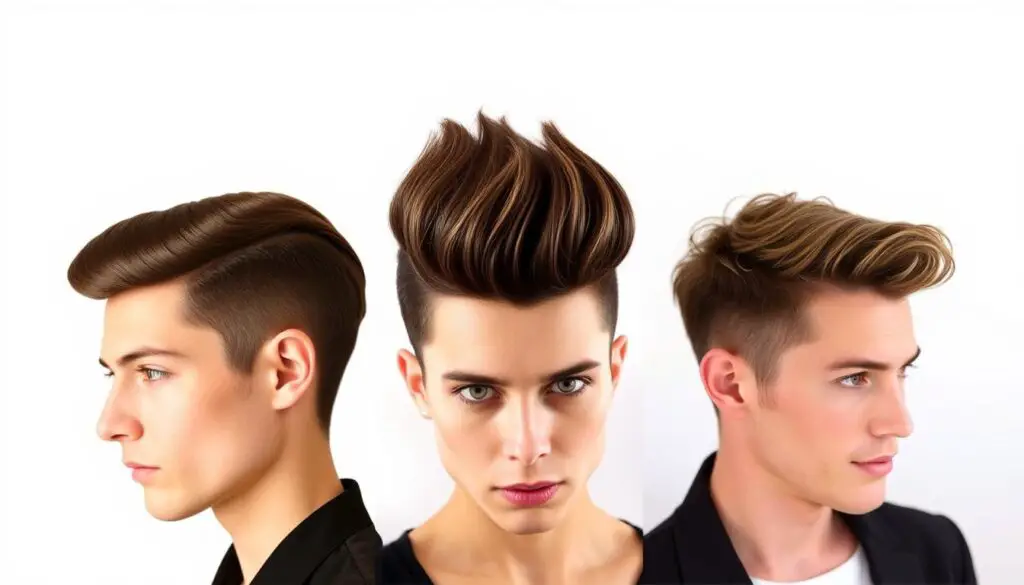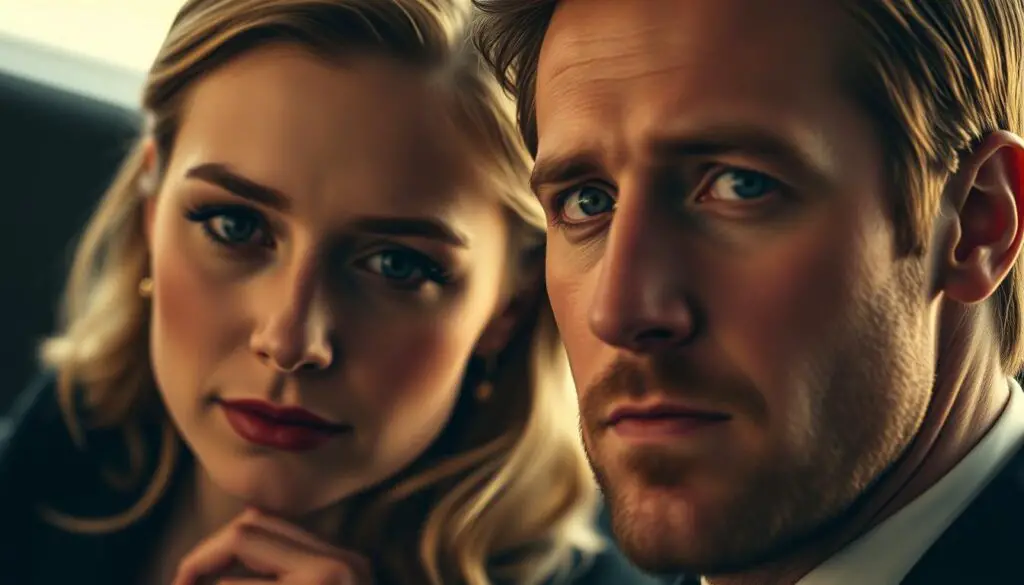For decades, hairstyles have cycled through trends, but few combine heritage and innovation like the modern quiff. This look balances vertical lift at the front with neatly styled sides, creating a sharp yet approachable aesthetic. Celebrities like Ryan Reynolds and Leonardo DiCaprio have popularized its versatility, proving it works for both red carpets and casual outings.
Unlike the classic pompadour, which relies on heavy volume and rigid structure, today’s quiff embraces texture and movement. Stylists achieve this by using lighter products and focusing on strategic layering. The result? A style that adapts to straight, wavy, or curly hair while maintaining a polished edge.
One of its standout features is how it complements various face shapes. For square jawlines, adding height softens angles. Oval faces can experiment with bold volume, while round shapes benefit from tapered sides to create balance. This adaptability makes it a go-to choice for men seeking a personalized look.
In this guide, you’ll discover step-by-step styling tips, product recommendations, and variations tailored to your hair type. Whether you’re aiming for office-ready refinement or weekend casual, the classic quiff’s evolution offers endless possibilities.
Key Takeaways
- Blends vintage appeal with current trends for a versatile look
- Celebrity-approved styling that works for multiple occasions
- Lighter hold and texture differentiate it from traditional pompadours
- Customizable to enhance square, oval, or round face shapes
- Includes practical guides for achieving and maintaining the style
Introduction to the Quiff Phenomenon
The 1950s didn’t just give us rock ’n’ roll—it launched a hair revolution. Icons like Elvis Presley and James Dean turned heads with voluminous top sections paired with sleek back sides, creating a bold contrast that defied convention. This became the blueprint for what we now recognize as the quiff.
Originally rooted in rebellious youth culture, the look evolved from greaser aesthetics to mainstream fashion. While its cousin, the pompadour, demands uniform fullness, the quiff focuses height at the front. This allows natural texture to shine through while keeping the sides and back neatly controlled.
What makes this style timeless? Its adaptability. Modern versions swap heavy pomades for lightweight creams, letting strands move freely. The core principle remains: elevated hair on the crown creates visual impact without overwhelming facial features.
Stylists often recommend tapering the back sides to emphasize the quiff’s signature silhouette. This balance works across hair types—whether you’re rocking tight curls or pin-straight locks. It’s no wonder this cut keeps reappearing in fashion decades after its debut.
Ready to explore how this iconic look can work for you? Let’s break down the tools, techniques, and tweaks that keep the quiff fresh in today’s grooming landscape.
Understanding Your Hair Type & Face Shape
Nailing that sharp, confident look begins with two factors: your mirror and your mane. Your face shape and hair type determine how the style lifts, falls, and frames your features. It’s like tailoring a suit—measurements matter.
Identifying Your Face Shape
Stand in front of a mirror. Trace your jawline, forehead, and cheekbones. Oval faces? You’re golden—most styles work. Square jaws shine with height at the crown to soften angles. Round faces benefit from shorter sides to create balance.
For triangular shapes, keep volume moderate. Heart-shaped faces can rock fuller fronts. The goal? Enhance your natural structure, not fight it. Stylists often taper the sides to draw eyes upward, making this trick universal.
Matching the Look to Your Hair Type
Thick hair handles bold volume but needs strong hold products. Fine strands? Use lightweight mousse and avoid weighing down the crown. Wavy textures add effortless movement—scrunch don’t slick.
Curly hair thrives with layered cuts and moisture-rich creams. Check your growth patterns too. Cowlicks at the front? Work with them for organic lift. As one barber notes: “Your hair’s personality should guide the style, not the other way around.”
Celebs like Chris Hemsworth (thick waves) and Timothée Chalamet (straight, fine hair) prove personalized tweaks make all the difference. Your turn to blend science with swagger.
Essential Tools and Products for a Flawless Look
Achieving that polished yet effortless style starts with the right arsenal. The right products enhance your hair’s natural texture while creating structure that complements your face shape. Let’s break down what belongs in your grooming toolkit.

Must-Have Styling Products
Start with a lightweight clay or wax for flexible hold. These add definition to the front without stiffness. For thicker hair, try a high-shine pomade—it tames frizz while boosting volume. Fine strands? Sea salt spray creates natural-looking texture and movement.
Pro tip: Apply products to damp hair. This ensures even distribution and makes styling easier. If your face shape is round, focus volume upward to elongate features. Square jaws? Soften angles with side-swept layers.
Effective Grooming Tools
A quality blow-dryer with a concentrator nozzle directs airflow for precise lift at the front. Pair it with a vented brush to add bounce at the roots. For detailing, a fine-tooth comb sharpens lines along the hairline.
Round brushes work wonders for adding curvature to straight hair. As celebrity stylist Mark Townsend advises: “Heat protection spray is non-negotiable—it prevents damage while locking in texture.” Keep a matte paste handy for midday touch-ups without buildup.
Step-by-Step Guide to Crafting Your Modern Quiff
Ready to transform your look? Let’s break down the essentials for crafting a head-turning style. With the right techniques, you’ll build lasting volume and sharp definition that adapts to any occasion.
Preparation and Blow-Dry Techniques
Start with clean, damp hair. Towel-dry gently to remove excess moisture—this helps products absorb better. Grab a round brush and blow-dryer. Lift sections at the roots, directing heat upward for natural lift.
Focus on the crown area, where most hairstyles need structure. Use medium heat to avoid damage. For extra oomph, twist the brush slightly as you dry. This creates bendable texture without stiffness.
If your cut includes a fade, ensure the sides are trimmed neatly. The contrast between shorter back areas and longer top adds edge. A tapered fade keeps the look balanced and modern.
Sculpting and Finishing Touches
Rub a dime-sized amount of matte paste between your palms. Work it through the roots first, then sweep upward to shape the style. Use your fingers to push hair forward, creating that signature lift.
For precise lines, comb the sides back. A light-hold spray locks everything in place. Avoid overloading—too much product weighs down hairstyles. One pro tip: “Mist the spray from arm’s length to distribute it evenly.”
Touch up any stray hairs with a dab of wax. Finish with a final blast of spray for all-day staying power. Now you’re set to own the room—no touch-ups needed.
Exploring Variations: Classic, Rockabilly, and Textured Quiff Options
Every great hairstyle evolves through reinvention, and the quiff’s journey from greaser staple to fashion favorite proves this rule. Let’s unpack three distinct approaches that keep this look fresh today.

Classic Quiff vs. Contemporary Adaptations
The classic quiff features a smooth gradient from short sides to a lifted front. Stylists often use a round brush to create gradual volume. This version works best for straight hair and formal settings—think business meetings or weddings.
For those craving edge, the rockabilly quiff pairs dramatic height with a sharp undercut. It demands stronger hold products like pomades and frequent touch-ups. Barber Luis Rivera notes: “This style needs confidence. The contrast between shaved sides and wild top makes a statement.”
Want something more relaxed? The textured quiff uses sea salt spray to create deliberate messiness. Scrunch damp hair upward, then let it air-dry for beachy waves. This works wonders for wavy or curly hair types needing a bit of structure without stiffness.
- Classic: Sleek, requires daily brushing
- Rockabilly: High-maintenance but eye-catching
- Textured: Effortless vibe, ideal for casual wear
Celebrities like David Beckham have mastered these tweaks. His recent red-carpet look blended a bit of rockabilly flair with modern texture. Whether you’re using a brush or fingers, remember: the best styles today balance personality with practicality.
Struggling to choose? Start with a sea salt spray base. Add pomade for polish or clay for grit. As hair pro Jen Atkin advises: “Play with products until your hair feels like an extension of your mood.”
Styling Techniques for Volume, Texture, and Definition
Mastering volume and texture transforms a basic style into a standout look. Whether you’re chasing bold lift or subtle movement, your tools and techniques make all the difference. Let’s explore how to balance natural flair with precise control.
Finger Styling vs. Brush Techniques
Fingers create effortless texture. Work a dime-sized amount of sea salt spray through damp hair, scrunching upward for beachy waves. This method suits textured quiff lovers who prefer a lived-in vibe. For structured shapes, use a round brush while blow-drying. Lift sections at the roots, rolling the brush forward to lock in height.
Celebrity stylist Jenna Brooks advises: “Finger styling adds personality, but brushes refine the silhouette. Combine both for dimension.” Thick hair benefits from brush precision, while fine strands gain volume with finger tousling.
Tips for Achieving the Desired Height
Start with a lightweight mousse at the roots. Blow-dry hair upside down to maximize lift. For rockabilly quiff enthusiasts, layer a strong-hold wax over pre-styled sections. Avoid overloading—too much product flattens strands.
Refresh midday with a dry shampoo spritz. It absorbs oil and revives volume without stiffness. If your crown sags, gently backcomb the base layers for invisible support. Finish with a matte salt spray to lock in texture and deflect humidity.
Curly or wavy hair? Enhance natural patterns with a curl cream before adding height. Straight hair needs light layers and strategic product placement. Remember: textured quiff styles thrive on contrast—sleek sides, wild top.
Maintenance and Aftercare: Keeping Your Look Fresh Daily
A great hairstyle doesn’t stop at the salon chair—it thrives through smart upkeep. The best quiff stays sharp with consistent care tailored to your men hair type and lifestyle. Let’s simplify your routine while preserving that red-carpet-ready edge.
Simple Daily Routine and Product Refresh
Start with a sulfate-free shampoo every other day. Overwashing strips natural oils, leaving the hair top dry. Pat damp hair with a microfiber towel, then apply a heat protectant before blow-drying. Focus airflow upward to maintain volume at the roots.
Midday touch-ups keep the best quiff intact. Carry a travel-sized matte paste or texturizing spray. Rub a pea-sized amount between fingertips and reshape the front. For face shapes like round or square, keep sides brushed back to emphasize angles.
James Dean’s secret? Minimal product and maximum confidence. His iconic style relied on lightweight creams reapplied sparingly. Follow his lead: avoid heavy gels that flatten movement. Instead, opt for flexible-hold clays or sea salt sprays.
Adjust your approach based on texture. Thick hair benefits from overnight leave-in conditioners. Fine strands need volumizing mousse at the roots. Curly types should scrunch in curl cream before air-drying. As stylist Marco Santini advises: “Treat your hair like fabric—gentle handling preserves its shape.”
Finish with a silk pillowcase to reduce friction. This prevents bedhead and keeps the styling products working longer. Pair these steps with regular trims every 4-6 weeks, and your men hair will stay gallery-worthy without the fuss.
Expert Inspiration: Celebrity Trends & Customizations
Legendary stars didn’t just wear hairstyles—they defined eras with them. Icons like James Dean and Elvis Presley turned the quiff classic into a cultural symbol, blending rebellion with sophistication. Their looks continue inspiring personalized adaptations that work for today’s diverse hair types and preferences.
Learning from Iconic Faces like James Dean and Elvis
Dean’s tousled, wind-swept style emphasized natural texture by using fingers instead of combs. Elvis favored polished volume with sharp top sides, creating contrast that framed his angular jaw. Both approaches prove timeless when adapted to your unique features.
Modern iterations balance these elements. For example:
| Feature | Classic Quiff | Modern Adaptation |
|---|---|---|
| Volume | Uniform height | Asymmetrical lift |
| Product Use | Heavy pomade | Texturizing spray |
| Styling Technique | Comb precision | Finger sculpting |
Tailor your version by considering your hair type. Straight locks? Try slicked-back top sides with a matte finish. Curly textures shine with layered cuts and light creams. As stylist Gina Rivera notes: “The goal is enhancing what you have—not forcing a trend.”
Experiment by using fingers to create messy peaks or defined ridges. This hands-on approach adds personality while honoring the quiff classic’s roots. Whether channeling Dean’s casual cool or Elvis’s bold flair, your interpretation keeps the legacy alive.
Conclusion
Your journey to mastering this iconic style starts with understanding three essentials: length, product precision, and balanced proportions. Keep the top layered for lift while trimming the side and back areas shorter—this contrast creates definition without overwhelming your features. A quality pomade or texturizing cream becomes your secret weapon, offering hold that adapts to your day.
While inspired by the pompadour, today’s version trades rigid structure for adaptable flair. It works whether you’re heading to the office or a weekend BBQ. The key lies in tailoring the length to your hair type and face shape, then refining with subtle side tapering.
Ready to make it yours? Experiment with product amounts and styling angles. Start with a pea-sized dab of pomade, then adjust. Remember: confidence transforms any look from good to unforgettable.
More than a trend, this cut bridges decades of grooming evolution. It honors tradition while embracing individuality—proof that timeless style always finds fresh ways to shine.
FAQ
Can a quiff work for all face shapes?
Absolutely! Oval and square face shapes naturally complement the look, but round or heart-shaped faces can rock it too. Adjust the height and volume to balance proportions—higher styles elongate, while softer textures add width.
What’s the best way to add texture without weighing hair down?
Use lightweight products like sea salt spray or a matte pomade. Apply them to damp hair, scrunching with your fingers for natural definition. Avoid heavy gels or waxes if you have fine hair.
How do I keep my quiff from collapsing by midday?
Start with a strong blow-dry using a heat protectant. Lock in volume with a firm-hold hairspray or clay. For quick touch-ups, carry a travel-sized texturizing powder to revive lift at the roots.
Is a fade on the sides necessary for this style?
Not at all! While tapered sides create contrast, you can opt for longer back and sides for a retro vibe. Discuss with your barber to tailor the cut to your hair type and personal taste.
Which celebrities have popularized the quiff over the years?
Icons like James Dean and Elvis Presley made it timeless. Today, stars like David Beckham and Timothée Chalamet showcase modern twists, blending sleekness with undone texture.
Can curly or wavy hair pull off a textured quiff?
Yes! Embrace natural waves by using a curl-enhancing cream. Blow-dry with a diffuser to lift the crown, then define strands with a light-hold product for effortless, lived-in appeal.
What’s the difference between a classic and rockabilly quiff?
The classic version focuses on polished volume, often paired with a side part. Rockabilly styles are bolder, with exaggerated height and retro flair—think vintage pompadour meets edgy texture.
How often should I wash my hair to maintain this look?
Limit shampooing to 2–3 times weekly to preserve natural oils. Use dry shampoo between washes to absorb excess grease and add grip at the roots for easier styling.









